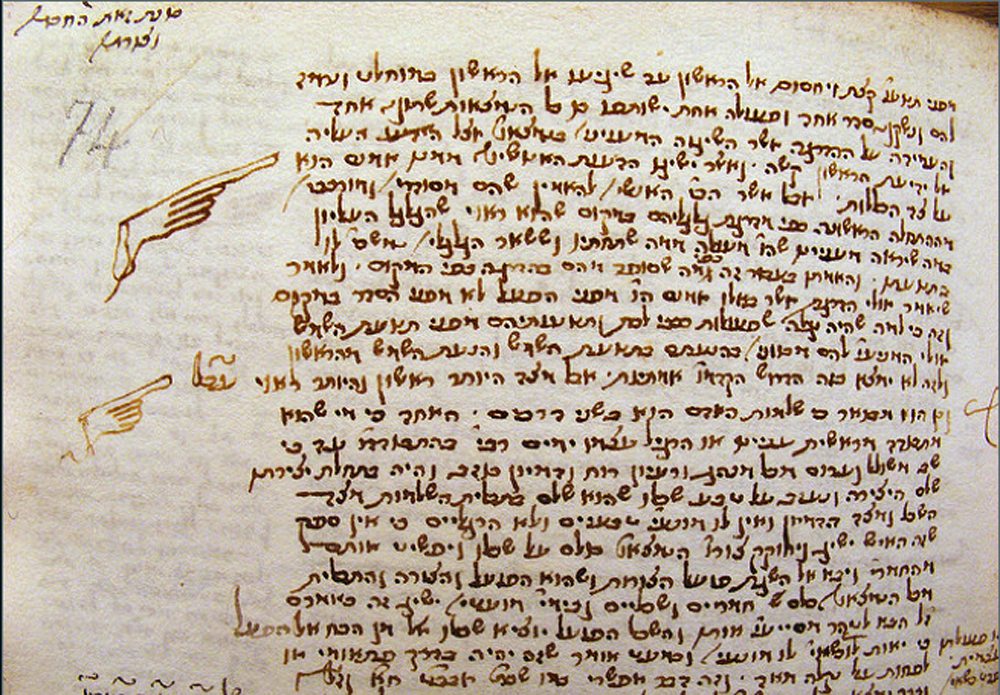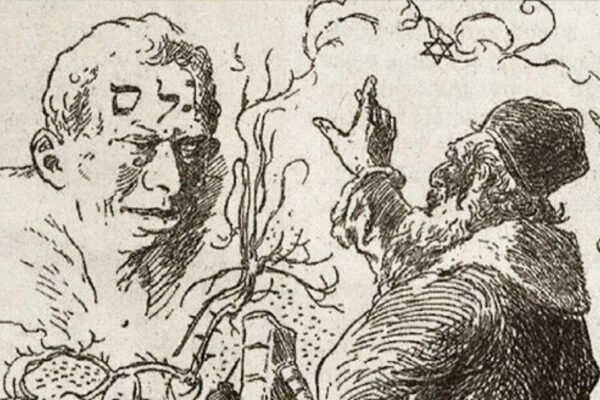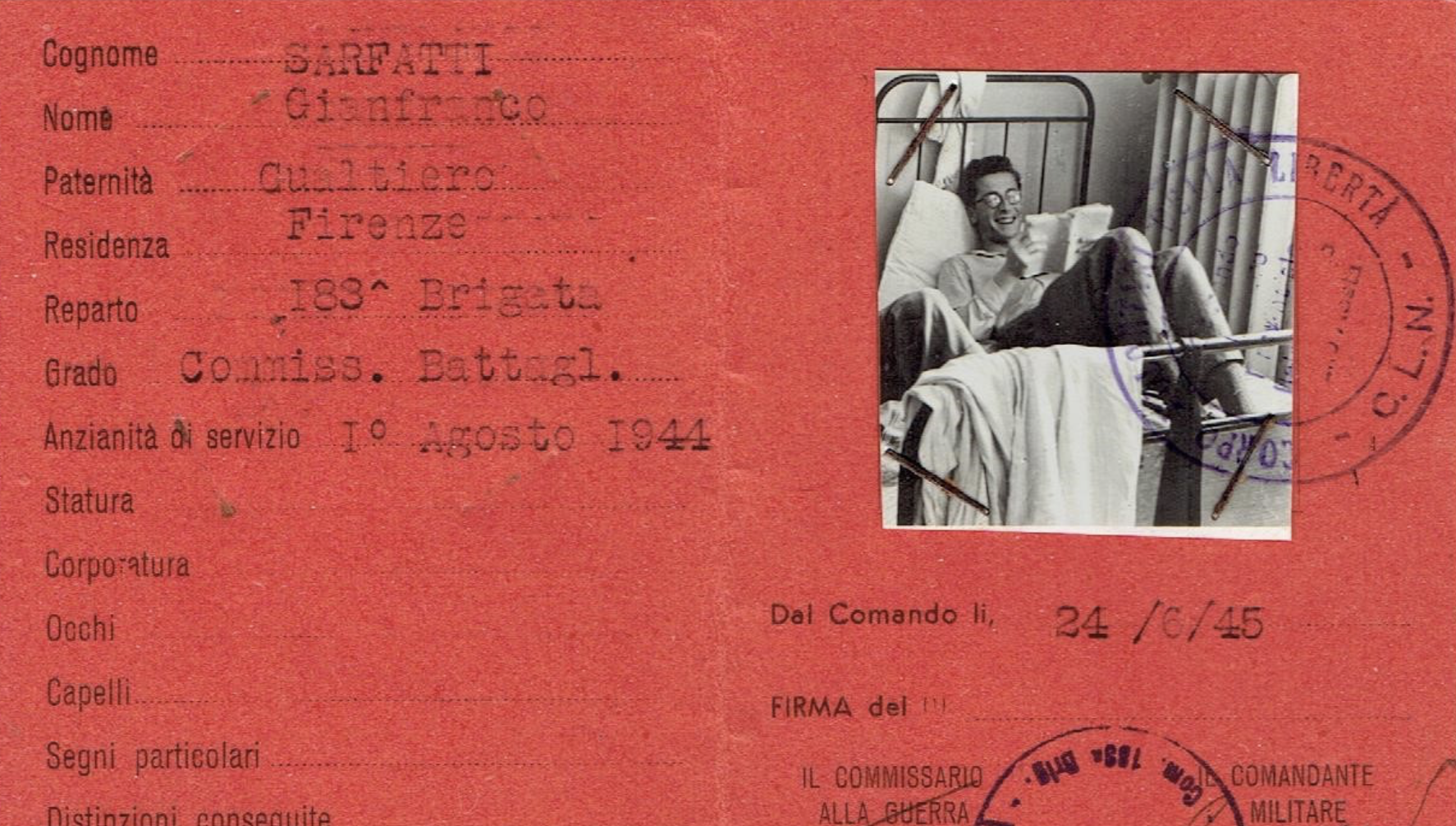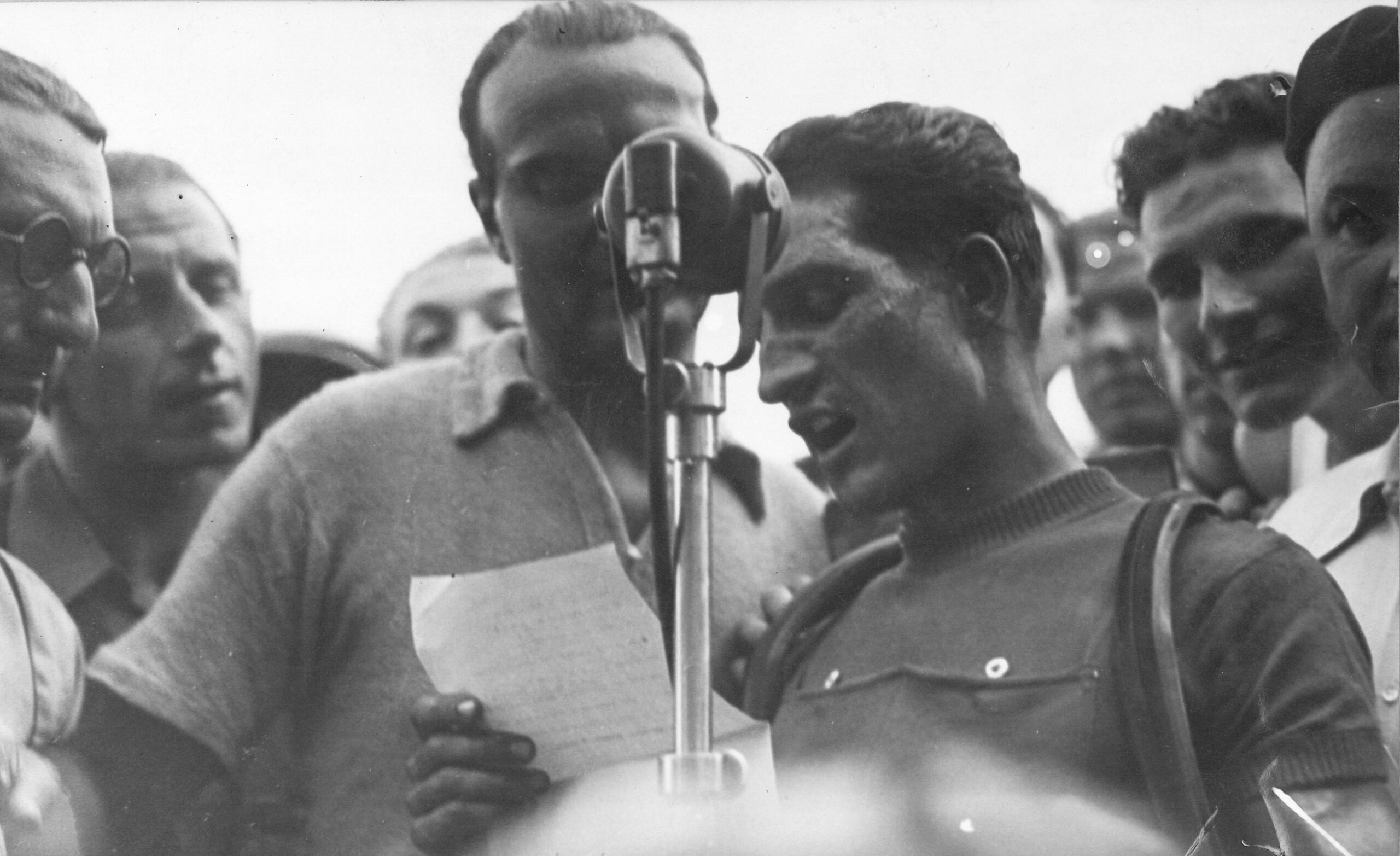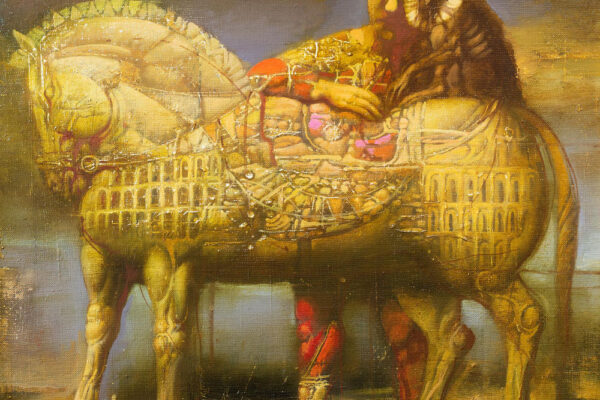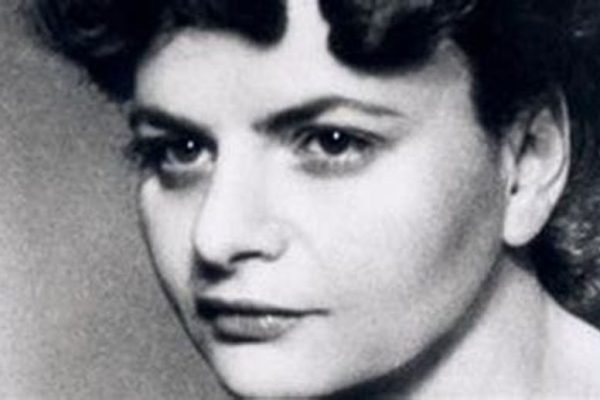Cultural Relationships between Jews and Non-Jews in Fifteenth-Century Italy: The Case of Yohanan Alemanno
Fabrizio Lelli is Associate Professor of Hebrew Language and Literature at the University of Salento (Lecce, Italy). His research focuses on the philosophical and mystical literature of late Medieval and Early Modern Italian Jewish authors and on the intellectual relations between Jewish and Christian scholars in the Italian Renaissance. Recently, he has been researching the works of Elijah Menahem Halfan, a 16th-century Venetian Kabbalist. This year at the center Lelli will continue to explore the life of Halfan in his study of the changing borders of intellectual freedom among 16th-Century Venetian Jewish scholars.
This talk was presented at the symposium “Humanism and the Rabbinic Tradition in Italy and Beyond” organized by Centro Primo Levi and held in New York in 2005.
1. Jewish Society in Fifteenth-Century Italy
The long coexistence of Jews within the non-Jewish Italian society has endowed Italian Jews with unique characteristics. Over the centuries, Italian Jewish communities, varying in size and authority, were generally open to the intellectual interests of the non-Jewish majority, and accepted some of the basic dynamics of the non-Jewish world, without losing their own autonomy and identity.
During the fifteenth century, Italian Jews continued adhering to the same tradition of intellectual exchanges with Christian scholars that had long characterized Italian culture. However, significant changes in the intercultural relations between Christians and Jews took place in the early Renaissance. This was partly due to the massive immigration of Jews fleeing to Italy from other regions of the European diaspora: instead of strengthening the connections within the Jewish communities on Italian soil, this socio-historical phenomenon fostered the scholarly dialogue between Italian Jews and Christian humanists.
In fact, Jewish intellectuals working in late medieval and early Renaissance Italy had long been accustomed to use traditions originating from different cultural areas. For instance, on the basis of a common interest in Aristotelian philosophy and the natural sciences, which allowed them to play the significant role of physicians in both northern and southern Italian regions, Italian Jews had been elaborating for centuries traditions imported from Byzantine and Iberian areas. Similarly, the philosophical tradition based on Maimonides was the result of a secular rethinking of Aristotelian and neo-Platonic categories originating in the Iberian peninsula and Provence, and adapted to the cultural life of Italian communities, where Jewish scholars shared some of the intellectual concerns of contemporary non-Jewish philosophers and theologians.
This specifically Italian tendency to adopt cultural motifs from other areas and adapt them to local non-Jewish traditions complicates the understanding of late medieval Italian Judaism’s intellectual framework. From this perspective, it should be stressed that some of the most common attitudes of fifteenth-century Italian Jews, which have long been recognized as resulting from the cultural influence of Italian early Renaissance thought, had already appeared in the intellectual production of learned Iberian Jews prior to their arrival on Italian soil. In other words, some of the most significant cultural concerns of the Italian Jews perfectly matched the traditional legacy of medieval Sephardic scholars.
Although the Ashkenazi population in Italy was not very large, Ashkenazi communities in northern Italy are well documented in the fifteenth century. This may be related to the ongoing migration of Ashkenazi families toward the south, which included also Spain. Some southern Italian Ashkenazi Jews decided to leave Italy for the Ottoman Empire, as did most Sephardic and southern Italian Jews after the 1492 and subsequent expulsions. Northern and southern Italian Ashkenazi communities were well integrated in Jewish cultural society of the Italian peninsula, although their attitude toward non-Jewish intellectual trends was apparently more reserved than that of the originally Italian Jews.
Starting at the end of the fourteenth century, northern European and Iberian Jewish scholars, forced to leave their countries, moved to Italy, bringing with them the most varied attitudes to the religious knowledge they had been accustomed to in their respective homelands. Once they reached the Italian peninsula, they could scarcely tolerate the dynamics of intellectual dialogue that Jewish and Christian scholars had been creating there. Ashkenazi and Sephardic Jews who migrated to Italy in the second half of the fifteenth century generally reacted against the trends current in the Italian milieus, whereas Italian Jews became more and more attracted by the humanists’ cultural achievements.
In particular, the neat distinction between Italian and non-Italian Jews was due to a major characteristic of the Jewish Italian tradition, that of merging Kabbalah with philosophy. This long-lasting trend of rationally interpreting Jewish mysticism gave rise, in the second half of the fifteenth century, to differing forms of intellectual Kabbalah upon which the cooperation between Italian Jews and Christians mostly focused. Jewish scholars from Spain and Germany realized that the diffusion of Kabbalah among Christians might become dangerous, since non-Jews were attempting to demonstrate the universality and superiority of Christian faith by adopting also the hidden doctrines of the Jews. The revelation of Kabbalah to Christians would ultimately destroy the very roots of Judaism, by allowing Christians to establish a much too close comparison between Jewish monotheism and Christian dogmas.
Therefore, outstanding foreign rabbis violently opposed the diffusion of Kabbalah among Christians, by addressing especially those Jewish communities in Italy where the encounter of Christians with Jews had produced new syncretisms of rational and mystical systems of thought. The Tuscan intellectual environment was especially blamed, since Jews there, by resorting mainly to Ficino’s neo-Platonism, were making use of magic and pagan hermetic theories to explain profound subjects of Jewish faith.
In the fifteenth-century Tuscan milieu, several Christian humanists were interested in Jewish Kabbalah, and Jewish scholars were ready to disclose their own Kabbalistic traditions to Christians. When Ashkenazi scholars, such as Judah Messer Leon or Elijah Del Medigo, warned Benjamin of Montalcino and the Florentine community against such a dangerous dialogue with Christians, Florentine Jews continued their tradition of intellectual cooperation with non-Jews. Analogous criticisms, addressed by a Sephardic scholar, Isaac Mar Hayyim, to the da Pisa family—the most outstanding banking family in fifteenth-century Tuscany—were also refuted.
This attitude of mutual incomprehension within the Jewish communities can partly explain why fifteenth-century Christian scholars borrowed Hebrew and Arabic traditions from their Jewish intellectual partners on a larger scale than in previous centuries, whereas the latter were willing to discuss and adapt many of the humanists’ trends of thought to their own research in order to stress their “Italian Jewish identity.” In this perspective, it is understandable why the same Oriental or pseudo-Oriental sources cherished by the humanists were also appreciated by Jewish scholars who read them according to their own interpretations.
All the above descriptions allow us to introduce the intellectual career of the Italian Jewish scholar who will be central to our investigation: Yohanan Alemanno.
2. Biography
Yohanan ben Isaac Alemanno (Alemanno [“German”] being the Italian translation of Ashkenazi) was born in Mantua (or, according to some documents, in Città di Castello, near Perugia) around 1435. His father apparently made his living from selling manuscripts. His grandfather, Rabbi Elijah, was a physician born in Germany, and it is from him that Yohanan inherited his family name. Yohanan’s grandfather lived for a while in France, moving then to Aragon, where Alemanno’s father married a Spanish lady. They probably went to Rome, where the King of Aragon sent Elijah as a diplomatic attaché to the Holy See. The entire family apparently remained in Italy afterward.
Yohanan, who reveals in his works that he lost his father as a child, became a protégé of the famed da Pisa banking family from Rome, active in Tuscany. We know that Elijah Alemanno had spent a short period in Florence in 1420, when Pope Martin V lived there. At that time Elijah might have befriended Yehiel of Pisa.
Owing to their extended financial network, the da Pisas maintained intellectual relationships with the most learned Jewish sages all over Italy and the Mediterranean basin. Among their scholarly acquantainces was one of the greatest Italian rabbis of Ashkenazi origin, Judah Messer Leon, who was renowned as a skilled doctor as well as a philosopher and an important halakhist and darshan. They also knew the most famed Iberian intellectual in Alemanno’s generation, Isaac Abravanel, who shared the destiny of the Jewish exiles and left Spain in 1492. Abravanel, whose encyclopedic production ranged from biblical exegesis to philosophy and messianic theology, was the father of Judah Abravanel, better known by non-Jews as Leone Ebreo, the author of one of the Italian philosophical best-sellers of the sixteenth century, the Dialoghi d’amore.
In Mantua and Padua, Yohanan Alemanno studied in Judah Messer Leon’s yeshiva, where he obtained the title of Doctor liberalium artium et medicinae in 1470. Back in Florence, he was a tutor to Yehiel of Pisa’s children. In 1488 or shortly before, he met the well-known Italian humanist Giovanni Pico della Mirandola, whom he mentions explicitly in his works. He spent most of the period between 1488 and 1493 in Florence and Pisa. In the final years of the fifteenth century he probably wandered about central and northern Italy (we find him in Ferrara, Bologna, and Mantua).
The date of Alemanno’s death is not known. He was still alive in 1505, when he was composing his unfinished commentary on Genesis, ‘Ene ha-‘Edah (The Eyes of the Community). His presence in Jerusalem was noted by a scholar, himself an Iberian exile, who wrote to Italy that on a date prior to 1523 an “old and wise man, Yohanan Ashkenazi, a universal sage” had come to Jerusalem. Whether Yohanan Ashkenazi is identical to our Alemanno is not certain. It is known, however, that many Italian Jewish scholars of the period felt a need to move to the Holy Land in the final years of their lives in order to witness the advent of the Messiah, who was expected to appear in the first decades of the sixteenth century. Alemanno himself stated that all Jews should gather in the Land of Israel before the Messiah achieved the redemption of their nation. Moreover, his age and the epithet he-hakham ha-kolel, the Hebrew rendering of the Italian uomo universale, perfectly suited Alemanno’s impressive culture.
3. Yohanan Alemanno’s Works
Alemanno has left a rich literary heritage, though most of his works are still in manuscript. In his writings he displays an amazing knowledge, which relies not only on classical Hebrew religious literature, but also on Arabic and Jewish philosophy, Kabbalah, the sciences, and magic. It is based on different Jewish traditions—Ashkenazi, Sephardic, Byzantine, and Italian—as well as on Greek, Roman, medieval, and contemporary non-Jewish literature.
Alemanno wrote a massive commentary on The Song of Songs titled Hesheq Shelomoh (Solomon’s Desire). Only its lengthy Introduction, known also as Shir ha-Ma‘alot li-Shelomoh (The Song of Solomon’s Virtues), has been printed, in the eighteenth century, as Sha‘ar ha-Hesheq (The Gate of Desire). Arthur M. Lesley has included a partial translation of this work in his Ph.D. thesis. A part of another voluminous treatise, Hay ha-‘Olamim (The Immortal), deals mainly with the different stages of man’s intellectual growth. Only fragments of this encyclopedic work have been published and translated. The above-mentioned ‘Ene ha-‘Edah, a much shorter commentary on Genesis, was left unfinished and still awaits publication. A lengthy and very precious untitled treatise, preserved in an autograph codex in Paris, contributes very important material for the understanding of Alemanno’s Kabbalistic sources. Last but not least, a manuscript now kept at Oxford preserves Alemanno’s autograph notebook (Liqqutim), in which many different sources were copied, some to be used further in the author’s literary career.
4. Yohanan Alemanno and Italian Humanists
Alemanno lived in a complex period: although he was the descendant of exiles, from whom he may have received most of his wide intellectual knowledge, many of his cultural attitudes match those of Italian Jewish scholars who lived in Italy in the early Renaissance. His curiosity and his interests in every scientific discipline make him a representative of the Jewish Renaissance. Moreover, Alemanno, unlike many contemporaries who never quoted their non-Jewish acquaintainces in their writings, seems proud to tell his Jewish readers that he is familiar with outstanding figures of Italian contemporary intellectual society, and that his role is not merely a passive one, but that he should be considered a “revealer” of the profound knowledge of famous Christian scholars.
In fifteenth-century Italy, many significant instances of intellectual cooperation took place between scholars of the two faiths. As in previous centuries, Jews and Christians could work together on biblical and philosophical subjects. Christian humanists, however, who reappraised the Hebrew texts of the Scriptures, now wanted to delve into their most secret meanings, by also taking Jewish traditional exegesis and Kabbalah into account. Since they thought that the ultimate truth should consist of the original texts of all sacred literatures, they sought the ultimate sources of mankind’s knowledge—those sources coming from the East. These allowed them to trace the roots of Christianity, which could be interpreted as a religious and intellectual system of thought integrating both Eastern and Western doctrines. The fall of Constantinople in 1453 to the Muslims, and the simultaneous flight of many Byzantine scholars to Italy, had enabled humanists to rediscover some of the classical texts that medieval culture had lost in the West. Florence and Venice were seen as the only real heirs of the Roman and Greek-Byzantine traditions, and as such, their intellectual environment appealed to any scholar of the time.
In this context one can understand the special concern in fifteenth-century Florence with pictorial representations of the Adoration of the Magi. The Oriental scholars of pagan faith who traveled westward to meet the infant Christ could be thought of as wise revealers of secret doctrines, hidden in the East, who visited the most prestigious centers of humanist Italy. For example, in the late 1450s, just a few years after the fall of Constantinople, following the attempt to reconcile the Western and the Eastern churches, Florence had become the center of a sort of “religious peace” process: many Byzantine scholars had fled there, bringing with them Greek manuscripts and their knowledge of Greek literature and thought. The Medici family decided to stress their role in bringing light from the Orient to the West by commissioning Benozzo Gozzoli to paint a fresco in their own private chapel representing the Journey of the Magi. In the long pageant accompanying the three “Oriental sages,” who symbolize the three stages of human life, members of the Medici family are portrayed along with Byzantine and Jewish scholars. Under the tolerant protection of the Medici, culture would flourish and the perfect Platonic republic would eventually be founded.
Gozzoli’s fresco in the Medici chapel in Florence is the perfect background for understanding why Alemanno was so proud to assert that, had he not come to Florence, he would have never had the opportunity to understand the true meaning of culture. Both in his Commentary on The Song of Songs and in his Hay ha-‘Olamim, he praised Florence and the Florentines (in the Commentary he adds specific praise addressed to Lorenzo de’ Medici) for being wise:
They [the Florentines] glorify and magnify the supreme wisdom, since from the theoretical wisdom comes forth the content of practical wisdom, for the theoretical is primary to the practical, in order to legislate laws that are taken from the theory, because lawgivers need to be wise in the theoretical wisdom, as Plato said: “The philosopher, the lawgiver, and the teaching priest are synonymous.” And therefore these are the people who lead the states and give laws at all times, according to their will.
Florence, the new Constantinople, was the place where the study of philosophy and the natural and divine law allowed people to live in peace through a holy wisdom, which was to be attained by means of the tolerant government of the Medici family. Thanks to the protection of the Medici, who were responsible for establishing a Platonic republic of the wise, a universal system of thought, in which politics and the sciences could coexist with religion and mysticism, would become the basis for the revival of a “Jewish nation.” From this perspective, Moses—regarded by humanists as one of those Oriental prisci philosophi (ancient philosophers) who had received intellectual secrets directly from God—was, to Alemanno, also the model of the perfect Platonic ruler who had assumed the roles of “the philosopher, the lawgiver, and the teaching priest” in order to govern his people.
Boasting his own intellectual skill, Alemanno writes in this context that Florence had the same impact on him that the land of Midian did on young Moses. According to the midrashic texts, which were cherished by both Jews and Christians in the early Renaissance, Moses was so learned because he had fled from his birthplace and had gone to live and study in a place distant from his family and people. Only those men who are willing to live far from their places of origin are able to fully understand the value of their own cultural tradition. It is as though Alemanno meant that Jews can better understand their faith when they live in a non-Jewish environment! This was, however, besides being part of Alemanno’s personal experience, the usual condition of Italian Jews in fifteenth-century northern Italy, where communities were small and intellectual contacts with non-Jews were common. In the author’s words:
Scholars of politics explain that adolescents, in the period extending from 14 through 21 years, imitate forms by means of the imaginative faculty of their souls, and strengthen their opinions, by moving their thoughts from the observation of a thing to the observation of something different. . . . This movement induces their hearts to seek and investigate, according to a quality which can be found in nature, as nature varies and modifies continuously; therefore, all those who do not let their intellect move from intelligible to intelligible, in order to see and understand, remain fixed in their habits and, in later phases of their lives, will not tolerate to see what differs from the reality they have been accustomed to know. That is why adolescents should change the places of their residence, moving from house to house, from town to town, in order for their souls and their natures to become accustomed to any sort of food, to any mealtime, to any clothing and habit, so that they will be ready to accept any human nature. Thus, they will not resemble animals, that, being sedentary by nature, never change their habits. We may observe that such was the attitude of our lord of science and prophecy [i.e., Moses], who spent two years of his life in his home, then in Pharaoh’s house, then in the house of Jethro, first in the land of Egypt, then in Midian, and later on in Nubia. Likewise behaved Abraham, Isaac, and Jacob, who never settled in only one place or followed only one system of thought, but accustomed their sensitive, imaginative, and rational souls to observing the change of different things.
By comparing himself to Moses in Midian, Alemanno is evidently stressing the importance of the period he himself spent in Florence. It was the rich intellectual atmosphere of the Tuscan city that enabled Alemanno to fully develop and put into practice his own broad Jewish culture, along with outstanding humanists such as Giovanni Pico della Mirandola, whom everybody praised for his wide-ranging intellectual interests.
In the Florentine environment, the role of a cultured man like Alemanno was significant. Wealthy Jewish families, seeking to distinguish their life from that of the non-Jewish milieus, displayed their high social position by engaging distinguished preceptors for their children. The rich banker Yehiel da Pisa hired Yohanan as a tutor for his children Isaac and Shemuel. Thanks to the renown of the da Pisa family, Alemanno’s fame spread all over Italy.
Disciples began arriving in Florence from other cities in order to study with Alemanno. One was David Messer Leon, who moved from Naples to study Kabbalah with him, thus rebelling against the anti-Kabbalistic attitudes of his own father, Judah. Alemanno’s openness to non-Jewish modes of thought inspired a harsh reaction from Isaac Mar Hayyim, a Sephardic refugee in Naples who exchanged letters with Isaac, son of Yehiel of Pisa. Alemanno’s student, referring to his Kabbalistic teachings, may have replied to Isaac Mar Hayyim by adhering to his mentor’s system of thought, which constituted also the basis of the Kabbalistic treatise composed by a later descendant of the da Pisas, Yehiel Nissim, Isaac’s nephew.
5. Yohanan Alemanno’s Intellectual Strategies and Cultural Achievements
Alemanno sought to give traditional religious studies a new interpretation: the interest of Jewish scholars in their own faith should now be part of a new, all-comprehensive system of thought, which should comprise both Jewish and non-Jewish philosophical and scientific traditions. Alemanno’s attitude toward intellectual knowledge can be described as encyclopedic: his works contain a systematic hierarchy of different forms of contemplative literature. As was the case with his medieval predecessors, the ultimate knowledge should be based on traditional authorities: the aim of the scholar was to integrate pagan, Christian, and Muslim texts into the true Jewish religious tradition. In this perspective, the study of philosophy was a necessary prerequisite for the attainment of intellectual perfection. What was new in Alemanno’s interpretation of medieval rational philosophy (based on works that had commonly circulated among Italian Jews since the beginning of the fourteenth century) was his reshaping of this intellectual legacy as the foundation of a non-rational higher form of speculation.
The Italian Kabbalistic tradition, since its late thirteenth-century emergence, had tended to interpret non-rational material according to rational categories. Alemanno followed in the footsteps of his predecessors, by stressing the non-rational aspects of the esoteric doctrine, and also by discussing contemporary speculative concerns that were current in Florentine humanist milieus. He devoted special attention to neo-Platonism, which is considered a valid system of thought for connecting rational thought and religion. This trend is related to the humanist search for the so-called prisca theologia (pristine theology), a motif that had been inherited from the patristic tradition and had been common in the Middle Ages. It was suddenly revived in Florence when the convergence of many cultures in the Tuscan city, under the auspices of the Medici, brought scholars to investigate all of human knowledge on the basis of a pristine wisdom coming from the Orient. This was a religiously oriented form of wisdom that allowed humanists to take magic and other hidden traditions into account, while investigating the nature of their own intellectual knowledge. In this context Kabbalah, as a hidden Mosaic discipline, could be read according to Hermeticism and Pythagorean traditions, along with the more traditional Platonic and Aristotelian categories derived from Iberian medieval texts.
By associating Plato and Kabbalah, Alemanno stressed the relationship between higher and lower cosmic entities. Viewing Plato as a scholar who had been influenced by Kabbalah allowed Alemanno to posit the higher value of Judaism vis-à-vis Christianity, and the necessity for non-Jews to become familiar with Kabbalistic texts in order to better understand the Platonic system of thought that they were rediscovering on the basis of its Greek originals. Alemanno also demonstrated, on a Kabbalistic basis, the dynamic influence of religious deeds—the mitzwot—on the higher world. Analogous parallelisms between Plato and Kabbalah were later developed by Leone Ebreo in his Dialoghi d’amore.
Thus, a philosophically oriented interpretation of Kabbalah was now accompanied by a magically oriented interpretation of the Jewish lore. The speculative and the magical understandings of Kabbalah were not in opposition, and sometimes even strengthened each other: knowing magia naturalis was tantamount to knowing the Sefirot, that is, the highest divine powers ruling over the mundane world. In Alemanno’s system, the Kabbalist is a sort of high magician who can manipulate the Sefirot for practical purposes. In his classification of various types of Kabbalah, Moshe Idel proposes to define Alemanno’s Kabbalah as a “magic talismanic model,” namely, one in which the main purpose of religious activity is the drawing down of the supernal spiritualities, stemming from the celestial bodies and the sefirotic realm, by performing certain rituals. In this perspective, Moses was the best model of a learned man and prophet who knew how to use the supernal powers received from God:
The kabbalists believe that Moses, peace be with him, had precise knowledge of the spiritual world which is called the world of Sefirot and divine names or the world of letters. Moses knew how to direct his thoughts and prayers so as to improve the divine efflux which the kabbalists call ‘channels.’ Moses’ action caused the channels to emanate upon the lower world in accordance with his will. By means of that efflux, he created anything he wished, just as God created the world by means of various emanations. Whenever he wanted to perform signs and wonders, Moses would pray and utter divine names, words and meditations until he had intensified those emanations. The emanations then descended into the world and created new supernatural things. With that Moses split the sea, opened up the earth and the like.
Alemanno’s special concern with magical and neo-Platonic Kabbalah was only partly inspired by non-Jewish contemporary scholars’ interest in it. This attitude had been manifest in Spain, where ecstatic Kabbalah had been combined with astral magic as early as the thirteenth century. Moreover, the Spanish Kabbalistic tradition of the fifteenth century stressed the role of magic in the Kabbalistic interpretation of the commandments. Like many other subjects of Alemanno’s thought, the magic exegesis of the Jewish esoteric tradition was derived from preexisting traditions, which this erudite scholar revived under the influence of the intellectual atmosphere of fifteenth-century Italy.
Like his Byzantine colleagues, Alemanno may have amazed his non-Jewish contemporaries by bringing to their attention some aspects of the traditional Jewish legacy that might help them better understand their own Christian tradition. By displaying his wide knowledge (Alemanno included an incredibly rich selection of Hebrew, Arabic, and Latin sources, ranging from the most common to the most unusual, thereby paralleling Giovanni Pico’s erudition), the Jewish scholar proved himself to be as brilliant and curious as his non-Jewish humanist colleagues, and equally interested in the rediscovery of ancient, or allegedly ancient, sources of knowledge originating in distant areas.
Bibliography
On intellectual relationships between Jews and Christians in Renaissance Italy see G. Sermoneta, «L’incontro culturale tra ebrei e cristiani nel Medioevo e nel Rinascimento», in Ebrei e Cristiani nell’Italia medievale e moderna: conversioni, scambi, contrasti, M. Luzzati, M. Olivari and A. Veronese eds., Rome 1988, 183-207; D. Ruderman, «The Italian Renaissance and Jewish Thought», in Renaissance Humanism: Foundations and Forms, A. Rabil ed., I, Philadelphia 1988, 382-433; H. Tirosh-Rothschild, «Jewish Culture in Renaissance Italy: A Methodological Survey», in Italia 9, 1-2, 63-96.
See Sermoneta, L’incontro culturale; F. Lelli, «Jewish Thought and the Renaissance», in Encyclopaedia of the Renaissance, P.F. Grendler ed., III, New York 1999, 321-325.
See M. Idel, Kabbalah in Italy (1280-1510): A Survey, New Haven and London 2011.
See M. Idel, «The Magical and Neoplatonic Interpretations of Kabbalah in the Renaissance», in Jewish Thought in the Sixteenth Century, B.D. Cooperman ed., Cambridge, Mass., 1983, 186-242.
On this phenomenon see R. Bonfil, Gli ebrei in Italia nell’epoca del Rinascimento, Florence 1991, 158; Idel, La Cabbalà in Italia (1280-1510), 216, 241 and passim; Eliyyah Hayyim ben Binyamin da Genazzano, La lettera preziosa (Iggeret hamudot), F. Lelli ed., Florence 2002, 37-39; 45-49 (English version forthcoming).
On Alemanno’s biography see Y. Alemanno, Hay ha’olamim (L’Immortale). Parte I: la Retorica, F. Lelli ed., Florence 1995; M. Luzzati, «Documenti inediti su Yohanan Alemanno a Firenze (1481 e 1492-1493)», in La cultura ebraica all’epoca di Lorenzo il Magnifico, D. Liscia Bemporad and I. Zatelli eds., Florence 1998, pp. 71-84; F. Lelli, «Alemanno, Yohanan ben Yishaq», in Encyclopedia of the Renaissance, P.F. Grendler ed., I, New York 1999, 40-42; Idel, Kabbalah in Italy (1280-1510): A Survey, 177-178 and passim.
See U. Cassuto, Gli ebrei a Firenze nell’età del Rinascimento, Florence 1918 (reprint: Florence 1965), 24-25.
See D. Kaufmann, «La famille de Yehiel de Pise», in Revue des Études Juives 26 (1893), pp. 83-110; 220-239; 34 (1897), 309-311; U. Cassuto, «La famiglia Da Pisa», in Rivista Israelitica 7 (1910), 9-19; 72-86; 146-150; 10 (1913), 48-57; A. Guetta, «Vita religiosa ed erudizione ebraica a Pisa e la crisi dell’aristotelismo: Yehiel Nissim da Pisa», in Gli ebrei di Pisa (secoli IX-XX), M. Luzzati ed., Pisa 1998, 45-67.
On Judah Messer Leon see Judah Messer Leon, The Book of Honeycomb’s Flow: Sepher Nophet Suphim, I. Rabinowitz ed., Ithaca, N.Y., 1983.
See E. Lawee, Isaac Abarbanel’s Stance Towards Tradition: Defense, Dissent, and Dialogue, Albany, N.Y., 2001; on the rich bibliography on Judah Abravanel see F. Lelli, «Leone Ebreo», in Encyclopaedia of the Renaissance, P.F. Grendler ed., III, 1999, 411-413.
See A. David, «A Jerusalemite Epistle from the Beginning of the Ottoman Rule over the Land of Israel», in Chapters in the History of Jerusalem at the Beginning of the Ottoman Age, Y. Ben Porat ed., Jerusalem 1989, 39-60 (Hebrew).
On Alemanno’s messianic concern with the Holy Land, see M. Beit-Arié and M. Idel, «An Eschatological and Astrological Treatise by Abraham Zacut», in Kiryat sefer 54 (1979), 174-194; F. Lelli, «The Role of Early Renaissance Geographical Discoveries in Yohanan Alemanno’s Messianic Thought», in Hebraic Aspects of the Renaissance: Sources and Encounters, I. Zinguer, A. Melamed, and Z. Shalev eds., Leiden 2011, 192-210.
See M. Idel, «The Study Program of R. Yohanan Alemanno», Tarbiz 48 (1979-80), 303-331 (Hebrew).
Y. Alemanno, Sha‘ar ha-hesheq, Livorno 1790 (reprinted in Halberstadt in 1862).
A.M. Lesley, The Song of Solomon’s Virtues by Yohanan Alemanno: Love and Human Perfection according to a Jewish Associate of Giovanni Pico della Mirandola, Ph.D. thesis, Berkeley, 1976.
See Alemanno, Hay-ha-‘olamim; F. Lelli, «L’educazione ebraica nella seconda metà del ‘400: Poetica e Scienze naturali nel Hay ha-‘olamim di Yohanan Alemanno», in Rinascimento, II ser., 36 (1996), 75-136; Id., «Prisca Theologia and Docta Religio: the Boundaries of Rational Knowledge in Jewish and Christian Humanist Thought», in Jewish Quarterly Review 91 (2000), 53-100; M. Reuveni, The Physical Worlds of Jochanan Alemanno in Hai ’Olamim, Ph.D. thesis, University of Haifa, 2004 (Hebrew).
On Alemanno’s works see Alemanno, Hay ha-‘olamim; Lelli, Alemanno, Yohanan ben Isaac.
On pictorial representations of Jews in fifteenth-century Florence and Benozzo Gozzoli’s fresco see F. Lelli, «Intellectual Relationships of Fifteenth-Century Jewish and Christian Scholars in Light of Contemporary Art», in Cadernos de estudos sefarditas 6 (2006), 149-170: esp. 156-157.
On this issue see A. Melamed, «The Hebrew ‘Laudatio’ of Yohanan Alemanno – in Praise of Lorenzo il Magnifico and the Florentine Constitution», in Studies Dedicated to the Memory of U. Cassuto, Jerusalem 1988, 1-34; F. Lelli, «Umanesimo laurenziano nell’opera di Yohanan Alemanno», in La cultura ebraica all’epoca di Lorenzo il Magnifico, D. Liscia Bemporad e I. Zatelli eds., Florence 1997, 49-67.
Y. Alemanno, Hay ha-‘olamim, Mantua, Biblioteca della Comunità Ebraica presso la Biblioteca Comunale, Ms. 21, f. 55r (English version by Melamed, The Hebrew ‘Laudatio’, 32-33).
See F. Lelli, «Moses Legislatorin Fifteenth-Century Italian Jewish and Christian Authors», in Moses Legislator, Proceedings of the Conference held at the Warburg Institute, London 2002, L. Campos Boralevi and C. Ligota eds. (forthcoming).
Alemanno here refers to Plato’s Republic, known to him via Averroes’ commentary in Samuel ben Judah of Marseille’s Hebrew version.
See Alemanno, Hay ha-‘olamim, 151-152.
On Pico as a rational philosopher, who “converted” to theology and eventually took vows and entered the Dominican order, see especially A. Raspanti, Filosofia, Teologia, Religione. L’unità della visione in Giovanni Pico della Mirandola, Palermo 1991. On the intellectual relationship between Alemanno and Pico see B.C. Novak, «Giovanni Pico della Mirandola and Johanan Alemanno», in Journal of the Warburg and Courtauld Institutes 45 (1982), 125-147; F. Lelli, «Un collaboratore ebreo di Giovanni Pico della Mirandola: Yohanan Alemanno», in Teologia a Firenze nell’età di Giovanni Pico della Mirandola, G. Aranci, P. De Marco and T. Verdon eds., Vivens Homo 5/2 (1994), 401-430; Id., «Yohanan Alemanno, Giovanni Pico della Mirandola e la cultura ebraica italiana del XV secolo», in Giovanni Pico della Mirandola. Convegno internazionale di studi nel cinquecentesimo anniversario della morte (1494-1994), G.C. Garfagnini ed., Florence 1997, 303-325. See also Giovanni Pico e la cabbalà, F. Lelli ed., Florence 2014.
On David Messer Leon see H. Tirosh-Rothschild, Between Worlds: the Life and Thought of Rabbi David ben Judah Messer Leon, Albany, N.Y., 1991.
See Guetta, Vita religiosa ed erudizione ebraica a Pisa; F. Lelli, «Pico, i Da Pisa e ’Eliyyà ayyim da Genazzano», in Giovanni Pico e la cabbalà, F. Lelli ed., Florence 2014, 93-120.
See Idel, La Cabbalà in Italia (1280-1510), 15.
Yohanan Alemanno, Sefer Hesheq Shelomoh, Ms. Oxford, Bodleian Library, Laud. Or. 103 (A. Neubauer, Catalogue of the Hebrew Manuscripts in the Bodleian and College Libraries, Oxford, Oxford 1886, n. 1535), f. 8v (English version by Moshe Idel, Kabbalah in Italy 1280-1510: A Survey, 186).


